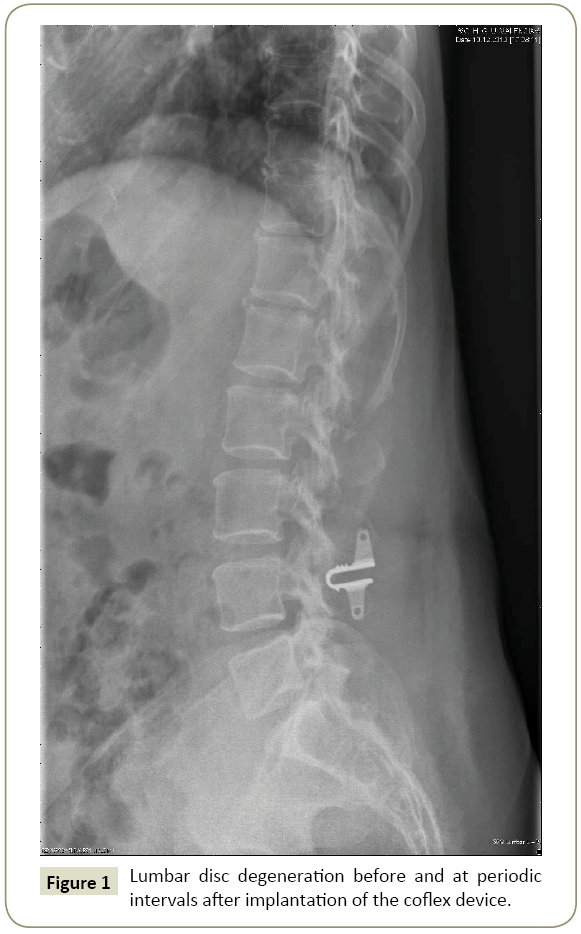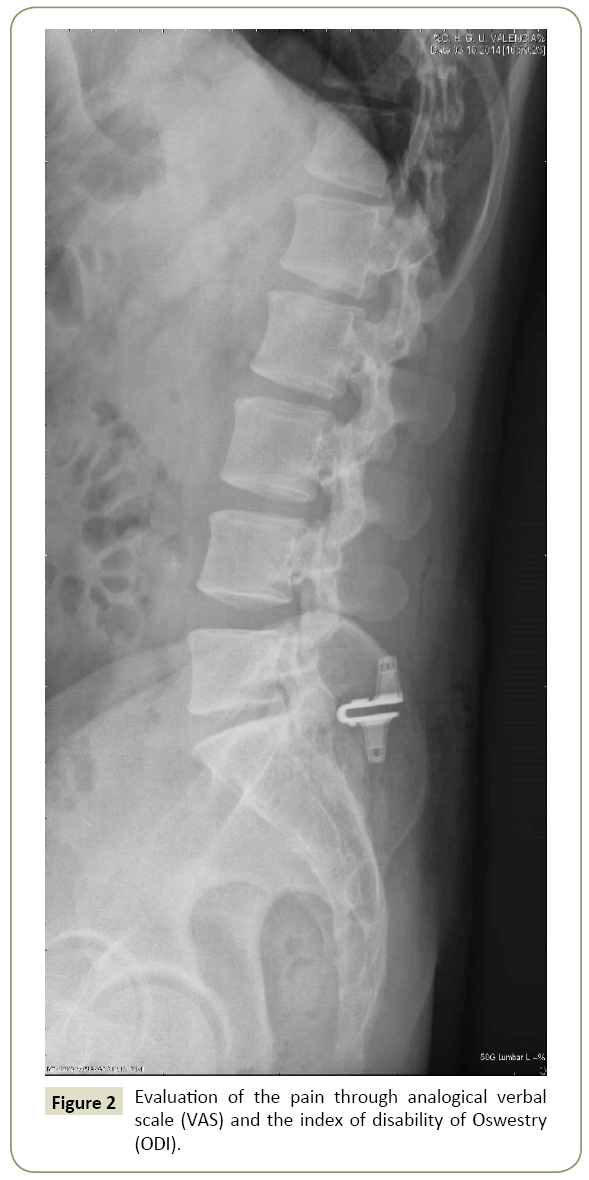Interspinous Distraction Device U May Avoid Posterior Artrothesis in the Future?
Inaki Arrotegui
DOI10.21767/2471-8173.100039
Inaki Arrotegui*
Department of Neurosurgery, General Hospital, Universitario de Valencia, Spain
- *Corresponding Author:
- Inaki Arrotegui
Consultant Neurosurgeon, Department of Neurosurgery
General Hospital, Universitario de Valencia, Avda Tres Cruces S/n. 46014-Valencia-Spain.
Tel: 00-34-627492961
E-mail: athbio@yahoo.es
Received Date: November 30, 2017; Accepted Date: December 14, 2017; Published Date: December 18, 2017
Citation: Arrotegui I (2017) Interspinous Distraction Device U May Avoid Posterior Artrothesis in the Future? Spine Res. Vol.3 No.3:19. DOI: 10.21767/2471-8173.100039
Abstract
The authors conducted a prospective study in patients with disc herniation. We compared the results obtained in patients treated with the U device with those acquired in patients treated without any device. The u implant is a titanium alloy device that is placed between the spinous processes. In a cohort of patients with degenerative Lumbar Disc underwent surgical treatment in which the U device was placed and control individuals were treated with discectomy alone. Patients underwent serial follow-up evaluations and radiographic assessment was used to determine outcome. Up to ten years follow-up data were obtained in all patients (2005-2006). Statistically significant improvement was seeing patients treated with the coflex device. In the management of lumbar disc degeneration, to avoid lumbar instability in the future 85% vs. 70% (p<0.01). Our study shows that the U device was more effective than the discectomy group in the management of lumbar instability.
Keywords
Interspinous U device; Lumbar spine surgery; Degenerative lumbar disc disease; Lumbar Instability; Microdiscectomy
Introduction
The cause of low back pain in 75% of cases are related to disc degenerative disease (D.D.D) [1]. After the beginning of the degenerative disc process originates a loss of height of the same, which causes alteration biomechanics of facet joints, which hypertrophies and causes lumbar canal stenosis [2] and, in turn, a thickening and bending occurs of the yellow ligament [3] that further aggravates stenosis. Various procedures have been investigated to treat the degeneration of the intervertebral disc, with methods biological (implantation of stem cells [4,5], proteins morphogenetic [6-8], tissue growth factors [9] that until now have not been successful, or through more aggressive surgical techniques such as disc prosthesis or fixation of the affected disc segment, arthrodesis. Another alternative is the socalled dynamic stabilization, that has been defined as a system that could alter favourably the movement and the transmission of load of a segment spinal mobile, without the intention of merging said segment [10] and avoid the cause of the pain [11]. They think that it reduces the load of the disc, restoring the tension of the posterior band, aligning the articular facets and increasing the disc height [12,13]. The latter have the advantage that can be implemented using a technique minimally invasive, preserving ligamentous structures of the spine. Studies in corpses have demonstrated that these devices reduce the pressure supported by the intervertebral disc, especially in the posterior region of disk and saucer [14]. The objective of this work was to analyze clinical outcomes and functional, after implantation of interspinous device, in patients with lumbalgias and claudication neurogenic secondary to lumbar degenerative disc disease.
Material and Methods
A retrospective study of patients diagnosed of lumbalgia and/ or sciatica due to Lumbar degenerative disc disease, between 2005 and 2006 through implantation U interspinous devices with follow-up at least of Ten years. 60 patients (40 men were included in the present study and 16 women), with an average age of 48 years (range 33-63 years old).
The inclusion criteria were patients affected by lumbalgia and/ or ciatalgia (24 low back pain, 20 lower back pain ciatalgia) secondary to degenerative disc disease, in that only one lumbar disc had protrusion disc with signal alteration (Phirmann changes), Likewise, failure was considered as an inclusion criterion of prior conservative treatment, of not less than 9 months of duration based on analgesic, anti-inflammatory drugs and rehabilitation.
We compared up to ten years outcomes of patients with post discectomy and coflex device versus patients who underwent surgery alone. Our goal was to assess the clinical outcome of patients with lumbar disc degeneration before and at periodic intervals after implantation of the coflex device (Figure 1). We also wanted to evaluate the mechanisms of action and effectiveness of interspinous distraction in managing symptomatic lumbar disc herniation to determine the safety and efficacy of the coflex implant and to avoid disc degeneration as described by White and Panjabi and Kirkalldy-Willis [14].
A preoperative study of the evaluation of the pain through analogical verbal scale (VAS) and the index of disability of Oswestry (ODI) (Figure 2). They were also made radiographic studies of the lumbar spine while standing and dynamic x-rays in flexo-extension. Repeating the same studies a year and 5 and ten years.
Regarding the surgical act, all patients were operated by minimally posterior approach over space affection (standard Technique).
Results
The intervened disc spaces were L3-L4 in 4 patients and L4-L5 in 20 patients and L5-S1 in 36 cases. Regarding the surgical act, there were no intraoperative complications, the surgical time was 45 minutes (35-58 minutes).
The standing and walking of the patients is started between 8 and 12 hours post-intervention, being Hospital discharge all patients to the next day of surgery. Regarding postsurgical complications, it was appreciated a superficial infection of surgical wound; we do not appreciate, no other complication than those described in the literature in the ten years of follow-up.
With regard to the clinical results, low back pain the preoperative EVA was 6.2 and a year down to 2.4, and the five year 2.8. and Ten to 2.2. As far as the sciatica picture is concerned, the preoperative EVA was 5.5 and one year after the intervention it was 1.7 and at 5 years 1.6. and Ten to 1.4. The preoperative ODI was 44 and a year after surgery it was 20 and at 5 years of 21 and Ten years 17 in the image studies.
Discussion
The results of our study show that the implantation of interspinous devices is a simple technique and safe, with few complications, totally reversible, in the treatment of low back pain and secondary lumbosciatica to degenerative disc disease with disc protrusion. Presents good clinical results in terms of evolution of the EVA and the ODI after intervention, and it seems to stop at part the disc degenerative process, with increased anterior part of the space disc in more than 80% of the patients who underwent surgery.
The implantation of an interspinous device is a less aggressive surgery for the patient with a surgical time short, with negligible blood loss (less than 50 ml), both in our series and in others reviewed [15], it is an easily reversible technique, since it respects all the functional structures of the spine. Likewise comorbidity is low, allowing ambulation a few hours after the intervention. Regarding the different existing interspinous devices in the market, we consider that the no conservation of the supraspinatus ligament has its small importance in biomechanics and stability of the lumbar spine. We have not had complications described in the literature as a rupture of the apophysis spinous, breakage of articular processes, or reactions allergic to the material (titanium) of the device.
Conclusion
Our results justify the placement of an interspinous device for the treatment of chronic low back pain in this type of patients. In order to better understand the long-term development after disc surgery and to prevent further degeneration namely lumbar instability a 10-years follow up was performed, with excellent results, but we believe an even longer follow-up is necessary to be referred to their placement monitoring to prevent or delay the appearance of Instability segment, as already mentioned, we have a historical group, conducted since 2006 with 10 years of follow up with an excellent result in relation to the delay of lumbar instability.
References
- Andersson GBJ (1981) Epidemiologic aspects of low-back pain in industry. Spine 6: 53-60.
- Kirkaldy-Willis WH, Wedge JH, Yong-Hing K (1978) Pathology and pathogenesis of lumbar spondylosis and stenosis. Spine 3: 19-28.
- Rauschning W (1987) Normal and pathologic anatomy of the lumbar root canals. Spine 12: 1008-1019.
- Crevensten AJL, Walsh D, Ananthakrishnan P (2004) Intervertebral disc cell therapy for regeneration: Mesenchymal stem cell implantation in rat intervertebral discs. Annals of Biomedical Engineering 32: 430-434.
- Sakai D, Mochida J, Yamamoto Y (2003) Transplantation of mesenchymal stem cells embedded in atelocollagen gel to the intervertebral disc: A potential therapeutic model for disc degeneration. Biomaterials 24: 3531-3541.
- Li J, Yoon ST, Hutton WC (2004) Effect of bone morphogenetic protein-2 (BMP-2) on matrix production, other BMPs, and BMP receptors in rat intervertebral disc cells. J Spinal Disord Tech 17: 423-428.
- Masuda K, An HS (2006) Prevention of disc degeneration with growth factors. Eur Spine J 15: 422-432.
- Masuda K, Oegema TR, An HS (2004) Growth factors and treatment of intervertebral disc degeneration. Spine 29: 2757-2769.
- Chujo T, An HS, Akeda K, Miyamoto K, Muehleman C, et al. (2006) Effects of growth differentiation factor-5 on the intervertebral disc in vitro bovine study and in vivo rabbit disc degeneration model study. Spine 31: 2909-2917.
- Sengupta DK (2004) Dynamic stabilization devices in the treatment of low back pain. OrthopClin North Am 35: 43-45.
- Mulholland RC, Sengupta DK (2002) Rationale, principles and experimental evaluation of the concept of soft stabilization. Eur Spine J 11: 198-205.
- Grob, D, Benini A, Junge A, Mannion A (2005) Clinical experience with the dynesyssemirigid fixation system for the lumbar spine: Surgical and patient-oriented outcome in 50 cases after an average of 2 years. Spine 30: 324-331.
- Christie SD, Song JK, Fessler G (2005) Dynamic interespinous process technology. Spine 165: 573-578.
- Swanson KE, Lindsey DP, Hsu KY (2003)The effects of an interspinous implant on intervertebral disc pressures. Spine28:26-32.
- Zuchermann JF, Hsu KY (2005) A multicenter, prospective, randomized trial evaluating the X STOP interspinous process decompression system for the treatment of neurogenic intermittent claudication: Two-year follow-up results. Spine 30: 1351-1358.
Open Access Journals
- Aquaculture & Veterinary Science
- Chemistry & Chemical Sciences
- Clinical Sciences
- Engineering
- General Science
- Genetics & Molecular Biology
- Health Care & Nursing
- Immunology & Microbiology
- Materials Science
- Mathematics & Physics
- Medical Sciences
- Neurology & Psychiatry
- Oncology & Cancer Science
- Pharmaceutical Sciences


